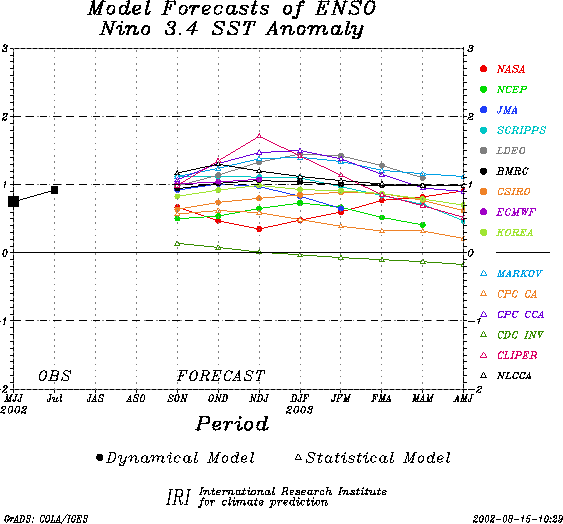
| ||||||||||||||||||||||||||||||||||||||||||||||||||||||||||||||||||||||||||||||||||||||||||||||||||||||||||||||||||||||||||||||||||||||||||||||||||||||||||||||||||||||||||||||||||||||||||||||||||||||||
Summary of ENSO Model Forecasts16 August, 2002 A note on interpreting the model forecasts: The following graph and table show forecasts made by dynamical and statistical models for SST in the Nino 3.4 region for eight overlapping 3-month periods. Note that the expected skills of the models, based on historical performance, are not equal to one another. The skills also generally decrease as the lead time increases. Thirdly, forecasts made at some times of the year generally have higher skill than forecasts made at other times of the year--namely, they are better when made between June and October than when they are made between January and April. Differences among the forecasts of the models reflect both differences in model design, and actual uncertainty in the forecast of the possible future SST scenario. The set of dynamical and statistical model forecasts issued during late July and early August shows a range of possible sea surface temperature conditions for the coming 3 to 8 months (September-October-November 2002 through April-May-June 2003). Most models are indicating a continuation of warm conditions. Most of the models forecast warming sufficient to be called an El Nino (e.g., warming to 0.6 degrees C or more above average in the Nino 3.4 region for the October-November-December seasonal average). A small number are forecasting ENSO conditions in the neutral category--less than 0.0 and 0.6 degrees C away from normal. The warmest forecast for the October-November-December period comes from the statistical CLIPER (multiple regression) model of Colorado State University and AOML, U.S. (1.35 degrees C above normal), and the coldest one is from the NOAA CDC's statistical Linear Inverse Model, calling for SST anomalies of near 0.1 degrees C. The SST anomalies forecast by the models for October-November-December tend to be forecast also for later periods, such as January-February-March 2003. For this later time, 12 of the 14 models that forecast to that long a lead time still suggest El Nino conditions: the NASA/NSIPP, the NCEP, JMA, Scripps, LDEO, BMRC, CSIRO, Korea SNU, CPC Markov, CPC-CCA, Colorado State CLIPER, and the UBC nonlinear CCA. The CPC Constructed Analogue and CDC Linear Inverse models predict SSTs that fall short of El Nino levels.
FORECAST SST ANOMALIES (>eg C) IN NINO 3.4 REGION
Some notes about the formulation of the entries in the table above: =>Only models producing forecasts on a monthly basis are included. This means that some models whose forecasts appear in the Experimental Long-Lead Forecast Bulletin (produced by COLA) do not appear in the table. =>The SST anomaly forecasts are for the 3-month periods shown, and are for the Nino 3.4 region (120-170W, 5N-5S). Often, the anomalies are provided directly in a graph or a table by the respective forecasting centers for the Nino 3.4 region. In some cases, however, they are given for 1-month periods, for 3-month periods that skip some of the periods in the above table, and/or only for a region (or regions) other than Nino 3.4. In these cases, the following means are used to obtain the needed anomalies for the table: o temporal averaging, o linear temporal interpolation, o visual averaging of values on a contoured map, and o regional SST anomaly adjustment using the climatological variances of one region versus that of another. As an example of the last case, suppose only the Nino 3 anomaly is provided. The Nino 3.4 anomaly is then obtained by decreasing the Nino 3 anomaly by the factor defined by the ratio of the year-to-year variance of Nino 3.4 to the year-to-year variance of Nino 3 SST, for the 3-month season in question. The anomalies shown are those with respect to the base period used to define the normals, which vary among the groups producing model forecasts. They have not been adjusted to anomalies with respect to a common base period. Discrepancies among the climatological SST resulting from differing base periods may be as high as a quarter of a degree C in the worst cases. Forecasters are encouraged to use the standard 1971-2000 period as the base period, or a period not very different from it. To top | Back | Technical Discussion | ENSO Update | ||||||||||||||||||||||||||||||||||||||||||||||||||||||||||||||||||||||||||||||||||||||||||||||||||||||||||||||||||||||||||||||||||||||||||||||||||||||||||||||||||||||||||||||||||||||||||||||||||||||||
